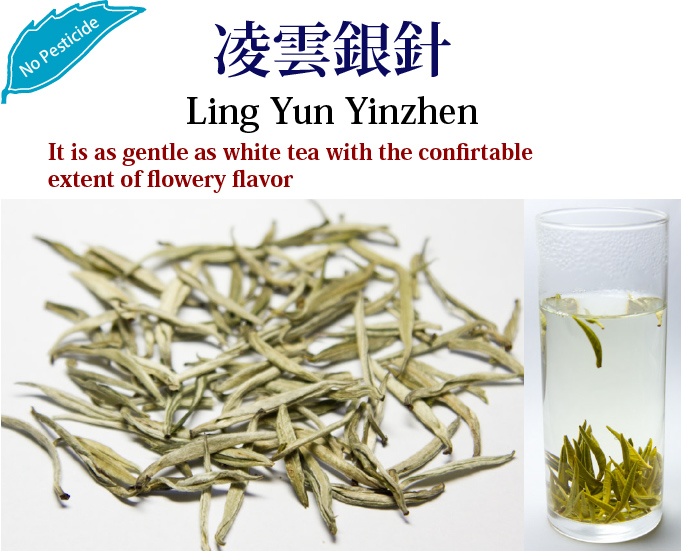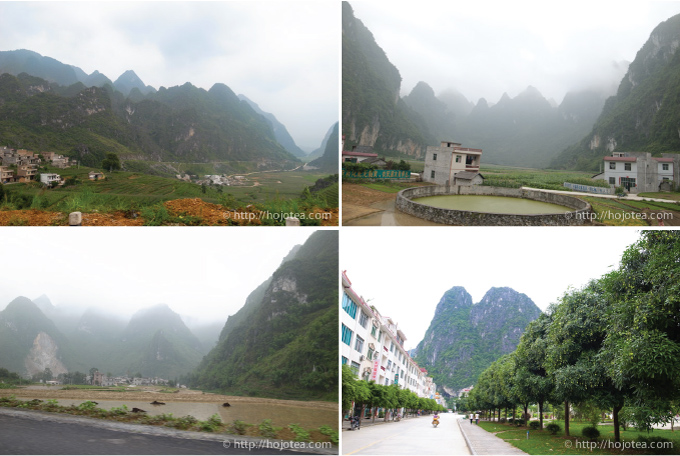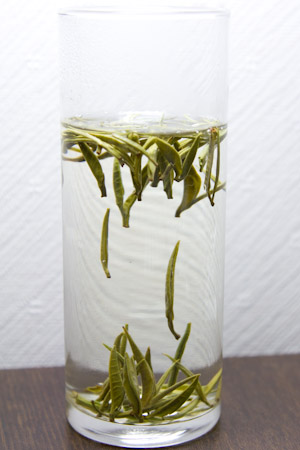
Thank you for visiting HOJO website. If you have any enquiry, please feel free to get in touch with us at
▼ Akira Hojo
▼ Hojo Newsletter
▼ HOJO FACEBOOK





HOME > Green Tea >Ling Yun Yinzhen

Ling Yun Yin Zhen is the sister of Ling Yun Mao Jian tea. Yin Zhen means silver needle in English. Literally it really looks like the silver needle or the fox tail in Winter.
Ling Yun Mao Jian is more intensively rolled, while the Ling Yun Yin Zhen undergoes very marginal extent of rolling. That is why the bud of Ling Yun Yin Zhen looks downy.
From the appearance, we often misunderstand that this tea is a white tea. In terms of process, the major difference is that Ling Yun Yin Zhen undergoes pan-frying, while white tea doesn't undergo pan-frying. The pan-frying process will cause the tealeaf being heated, and enzymes are inactivated.
By the way, it is very difficult to produce this tea. It is made by the single bud hand-plucked in March. In a day, a skilled tea-plucker can only collect a maximum of 500 grams of fresh buds. After the process, the weight of tea reduces to 100g. Because of the beautiful appearance and the rareness, this tea is often used as a gift for government. In a way, it is very hard for us to purchase this tea.
The major process of Ling Yun Yin Zhen and white tea is different, nevertheless, the character of this tea is quite close to white tea. This tea is suitable for white tea lovers, yet wishing for a tea with slightly stronger flavor. On first brew, this tea gives strong flowery flavor and the aroma of the leaves evokes sweet corn and slight grassiness. From the second brewing, it also gives a hint of nutty flavor like chickpea. It gives a comfortable lingering aftertaste that lasts for a long time.
This tea is an ideal tea for cold water brewing. It's a simple preparation: place 5g of tealeaf in 1 liter of water for 1-2 hours or more. You will enjoy a soothing drink, especially during summer.
Usually the local people use a long glass to brew this tea. After a while, leaf absorbs the moisture, it turns yellowish green and start moving up and down as if the leaf in the bamboo forest is falling down. You can refill hot water into the long glass, and brew this tea over and over again.

The ling yun bai hai cultivar on the left photo looks very different from the ordinary tea leaf. The photo on the right shows ling yun bai hao (right) and normal cultivar (left) side by side.
I often meet customer who has never tried Chinese green tea. In fact, more than 50% of teas produced in China is the green tea. Out of many Chinese green teas, I think Guangxi green tea is a very good choice for tea beginner. This tea has a very appealing flowery flavor, anyone can be easily enjoy. Some customers commented that the flavor of this tea resembles the flavor of Darjeeling first flush. Somehow I agree that this tea reminds me of very fine Darjeeling first flush.
Guangxi has been famous for the production of jasmine flower for jasmine tea. Since there were a huge demand of jasmine tea in European country, Guangxi government has encouraged and reinforced organic tea garden concept started from many years ago. For now, many tea gardens in Guangxi practice organic production. Our Cui Luo is also produced from the non-pesticide tea garden.
Good tea will never grow fast. The slower the tea grows, the smaller the cell becomes, and the more number of cell is formed within each tealeaf. Since each cell is the factory to produce the functional substance for tea, the more number of cells, the more substance the tea produces. Thanks to the large number of cell, it produces plenty of poly phenol and accumulates mineral in it, in particular iron. Minerals are the essential substances that increase the aftertaste of tea proportionally. Exactly the same theory is applied to the production of apple or any other fruit and vegetable. If nitrogen-based fertilizer is applied, the apple tree grows pretty fast and apple also becomes bigger. However the apple becomes less tasty yet very watery. Based on this theory, we are selecting the garden that uses no fertilizer or limited usage of organic nitrogen-based fertilizer. As a result, when you drink this tea you will experience a complex taste and flavor.

One teaspoon of tealeaf fully expand in a Gaiwan. You may be surprised that it expands so much! Each piece of Cui Luo contains one bud and two leaves that is hand-plucked one by one. This tea has very clear liquor with bright yellowish hue. The clear liquor indicates that less dust was generated during the process as the tealeaf is very elastic and tender thanks to the huge number of cells. As a result, although its liquor is so light, the flavor and aftertaste of tea is strikingly thick.

In you are using tap water, it is necessary to filter the water using an activated carbon filter. If not, you wouldn’t be able to enjoy the authentic taste of tea. Chlorine is added to tap water in order to sanitize bacteria. This chlorinated water will also harm our body cells. Concerning about our health condition, it is very important to remove chlorine from drinking water. The most effective method in removing chlorine is to install an activated carbon filter. This type of filter is designed for removing organic substance. It will remove not only chlorine, but also other harmful substance such as contaminated pesticide. The activated carbon filter can be easily obtained from the common hardware shop in most countries. If activated carbon filter is not available, please place a charcoal inside the water and leave it for over night. The material composed of activated carbon filter is made of ground charcoal. The difference is that activated carbon filter contains much finer particles and hence it has extremely large surface area for a better efficiency in filtration. We do not suggest RO water (reversed osmosis water) or distilled water. This water carries no mineral, the taste and flavor of tea tends to be very unstable, unless you have very superior quality tea and tea equipment.
In the long run, you may observe a thick layer of scale accumulated inside your kettle. Our mother usually taught us to wash and remove it with citric acid. But please do not even try to remove the scale. Scale consists of minerals that exist in the water. The mineral composition is reflected from the water you used. If you remove the scale, the mineral ion balance between scale and water is destroyed. This balance is called buffer effect in science. The flavor and taste will seriously run out and you won’t be able to get previous taste and flavor for a long time. It is also important to stick to the same type of water whenever brewing tea. If source of water is changed, it carries different type of minerals. It will affect the mineral ion balance too.
Go to further information about suitable water for brewing tea >>
The quantity of tea leaf can be calculated by a formula that "Divide the Volume of Water by 5". For example: the volume of teapot = 200ml; 200ml/50 =4g. You need to measure 4g of tea leaves for 200ml of water. As opposite to the traditional brewing method, the modern style uses more volume of water. A teapot with the size about 150-220ml is just nice for one person.
Cool down the boiling water to 80 degree Celsius. Use the same temperature for a series of brewing until you feel the taste no long remains. Finally, you can use boiling water to bring out the remaining taste and flavor.
For sencha, the first brewing period is 1 minute.The second brewing must be less than a few seconds. The third brewing is the same. From the forth brewing onwards, increase to additional 10 seconds for the each subsequent brewing.
Clay teapot and Tetsubin makes the taste of Sencha even better. It is mainly because of the iron that is released from the equipment. In particular, the iron enhances the depth of after taste.
It is also very nice to brew this tea in the long glass as above photos. In particular, I suggest this method if you want to drink tea at work or when you do not have enough time to all the way prepare tea using teapot. All you have to do is to put one tea spoon equivalent quantity of the leaf and pour hot water that temperature is at around 80 degree C. Once you finsh drinking tea, you can refill the glass with hot water over and over again.

It is also very nice to brew this tea in the long glass as above photos. In particular, I suggest this method if you want to drink tea at work or when you do not have enough time to all the way prepare tea using teapot. All you have to do is to put one tea spoon equivalent quantity of the leaf and pour hot water that temperature is at around 80 degree C. Once you finsh drinking tea, you can refill the glass with hot water over and over again.
Most of Green Teas can be brewed in cold water. The higher the grade of tea, the more suitable it is with cold water brewing.
1. Measure 1 table spoons of tea leaves for 500ml of water.
2. Pour the water into a glass jar or bottle and leave it for more than 1 hour.. It is also a good idea to put the tea leaves directly into a PET bottle.
3. Gently sway the container in order to get an even concentration.
4. Usually the taste of tea gets thicker when it is brewed for more than a few hours. In this case, pour in additional water. Eventually tea can be brewed more than 1 liter per 1 table spoon of tea leaves.
1. Measure 4-6g of tea leaves for 200ml of water.
2. Pour water into a clay teapot and brew for 3 minutes.
3. For second brewing, brew for 20 seconds. Alternatively you can also switch to hot water from second brewing onwards, if you wish. If using hot water for second brewing, pour boiling water and brew for less than a few seconds. Since tea leaves are very cold and wet, the temperature drastically drops to less than 60 degree Celsius.
The benefit of cold water brewing is tea can last for a whole day and the taste is refreshing with a natural sweetness. Thanks to the cold water extraction, the level of caffeine in tea is very low. You would not suffer from sleepless nights. Even kids can enjoy this tea.
Once a bag of tea is opened, please finish it within 3 months if you wish to enjoy its freshness. From the medical point of view, it is safe to consume the tea even if it is kept for a few years. However the freshness disappears if it is kept for too long. Tea must be tightly sealed before it is kept. Tea should be kept in ambient and dry conditions such as in the living room, but it must be completely away from humidity. Tea should not be kept in the kitchen as the environment is very humid. Avoid enclosed area such as inside the cupboard or drawer as these places are damp. Also avoid opening the bag of tea in humid atmosphere. It is recommended to open the bag during a sunny day or under air-conditioned atmosphere. Once tea leaves absorb moisture, deterioration of tea will be triggered within a few days. Tea will then give an astringent taste, sometime it tastes sour. The fresh aroma also becomes weaker.
The quality of tea lasts longer if it is kept in the fridge. However we strongly recommend you not to keep tea in the fridge. When tea is withdrawn from the fridge, there is usually condensation. Once tea is exposed to moisture during condensation, the quality will deteriorate within a few days. The higher moisture content in the tea leaves will trigger oxidation and it will completely destroy the quality of tea.
Here’s one frequently asked question: what happens if bag is sealed using tape or tea is packed in zipper bag and kept inside the fridge?
For your information, these simple sealing methods are not sufficient. When the bag is withdrawn from the fridge, it is cold inside the bag and therefore causes negative pressure. Air will be drawn from outside and condensation will occur. In addition, if the bag is taken in and out from the fridge very often, this will cause heat stress to the tea leaves as temperature is increased and decreased very frequently. If tea is kept in the fridge, when it is withdrawn from the fridge, it is necessary to leave it in ambient atmosphere for more than 24 hours in order to warm up the tea leaves. Based on our experience, 12 hours is not long enough. We may think tea is warmed up, but inside the bag, the tea leaves are still cold due to insulation effect.

Please feel free to send us e-mail for enquiry at:

 |
We accept various kinds of credit card through Paypal.
Only if customer prefer other option of payment, we suggest "Bank Transfer".
Various choice of shipping method
EMS, SAL, Small Packet, Small Packet (SAL) Yamato Express and Surface
For shipping tea, we usually suggest small air parcel, the estimated shipping cost of tea in 100g (with wrapping material ) is
Small Parcel
USA JPY 600, EU JPY600 and Asia JPY470
Small Packet (SAL)
USA JPY380, EU JPY380 and Asia JPY320
The shipping fee to oversea by small air parcel happens to be even cheaper than domestic shipping fee in Japan.
For your information, some countries, EU in particular imposes custom duty. We need buyer to bare the duty. We are sorry, but we cannot change the amount on the invoice, and we do not mark any packages as gifts. We will strictly follow the custom regulation.